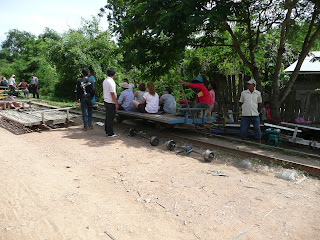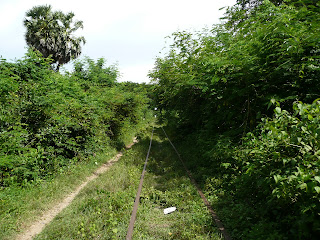We started the journey with a 3am wake up phone call from the mini van driver who called round our house to pick us up. Then the battle began to get a seat in the bus but to be able to put my feet on the floor and not sit with legs bent on a big sack of wood etc.
By mid day we were in Phnom Penh and caught a bus to Battambang, arriving about 6pm , a long day of travel.
One of the reasons I wanted to visit was to ride the Bamboo train described in the Lonely Planet guide as one of the world's all- time classic rail journeys- ........the train clicks and clacks south east to O Sra Lav along warped, misaligned rails and vertiginous bridges left by the French.
The following article emailed to me by a friend describes a typical experience:
It rattles along at 20 miles an hour, swaying back and forth on uneven rails, the engine so loud it makes your teeth hurt. Then, rather unceremoniously, it runs out of petrol and dies.
And you find yourself stranded in the middle of Cambodia on a handmade "norry" train, feeling a bit exposed on a 25-square-foot platform made of bamboo and scrap metal attached to wheels salvaged from old tanks.
Picture one of those hand-pump rail cars depicted in old Westerns, and you're close. It's powered (when it has petrol) by a converted outboard engine. The brakes (when it has petrol and you need brakes) are a wooden board pushed against the wheels. No seats.
All this bamboo and scrap metal give it a makeshift appearance, and appearances do not deceive. Pretty soon, driver Path Chanthorn starts pushing the disabled norry with hands that are missing a few fingers from a run-in with a water buffalo -- "a strong cow," he mutters.
Another norry approaches from the opposite direction, every inch of its platform covered by a dozen people headed for a festival. With a single track to ride on, etiquette dictates that the norry with the lighter load be taken apart so the other can pass. So Chanthorn and his assistant quickly dismantle their vehicle and let the other one by, then put theirs back together again, all within minutes.
And you are on your way.
Now a government plan to upgrade the country's rail system may end up forever stranding the norry, an ingenious response to the decades of war, destruction and dire poverty that have afflicted Cambodia.
Under the Khmer Rouge in the mid-1970s, as the country descended into civil war and mass murder, 2 million people perished. And in leader Pol Pot's quest to reach "Year Zero," Cambodia also saw most of its roads destroyed, its trucks blown up, its locomotives charred.
By the early 1980s, as Cambodia started to emerge from the nightmare, people remembered the small vehicles used by rail workers in the 1960s to repair the tracks and started building their own. The norry, a name some say is derived from a mispronunciation of "lorry," was born.
The humble norry is a reminder of how much Cambodians lost, but it also speaks to their persevering spirit. All but left for dead under Pol Pot's genocidal regime, they defied the odds to rebuild, sometimes literally: Witness the land mine victims who picked up their lives by crafting homemade wooden limbs.
"It shows how ingenious people can be," says Ith Sorn, 55, who's been driving norries for three decades. "Cambodians came up with this when they had almost nothing."
The unique mode of transportation saw its heyday in the 1980s when other vehicles were scarce. "There were bombs and mines everywhere, roads were destroyed and rail cars a shambles," says Kot Sareurn, 50, a union leader for 23 norry drivers in Battambang, a picturesque provincial capital along the tranquil Sangker River. "Norries helped a lot of people survive, get to hospitals, get food."
Initially operators "rowed" the norries with poles, gondola-style, carrying loads of up to 40 people, eight cows or three tons of rice. After a few years, small gas engines were added.
So what about our experience riding the train?
Angela and Nichole sat on the bamboo train:
A view down the track .Yes the rails are very much out of line the worst points are at the butt joint of two rails which produce a lound bang and jolt when you pass over them.
Just about to set off. Note the wheels from another train lying on the ground
Moving a train off the track to allow another to pass.
Nearly ready for our train to move forward
The engine and drivers seat. the stick in the foreground of the pic is used to lever the engine block and put tension on the drive belt to give motion to the wheels. Moving the lever the other way releases tension the drive belt goes slack and the wheels loose the driving force. The brake is a board pushed against the wheels by the drivers foot.
Nice and light to pick up, the train is lifted off the wheels.
Getting ready for the return trip. This picture shows the train and how the passengers sit on it.
So now enjoy the video I shot from my perch at the front of the train. Watch until the end when you see we wait for an approaching train. This then stops in front of us and the drivers dismantle the train so our train can move forward and pass. They then put the train back together and proceeded away from us in the opposite direction.
So after a trip like that what is ther left to do?
Buy the T-shirt of course, been there ,done that, bought the T shirt.











One of the best non-controversial stories I've read on this blog since it began 21 months ago.
ReplyDeleteYou are making the most of your experiences and helping couch-potatoes like me live through your words and images.
Please keep finding new experiences to share - we like your tales and want many more and want you to match 2011 output.
Heroic.